Yellow
Yellow (RGB)
Yellow (CMYK)
Yellow (NCS) S 0580-Y
Yellow (Munsell) 5Y
| Yellow | ||
|---|---|---|
|
|
||
| — Spectral coordinates — | ||
| Wavelength | 570–580 nm | |
| Frequency | 525–515 THz | |
| — Common connotations — | ||
| sunshine, warmth, fun, happiness, warning, friendship, caution, slow, intelligence, cowardice, love, Mardi Gras, summer, lemons, Easter, autumn, electricity, libertarianism, hope, optimism, imagination, curiosity, surprise and thrill | ||
|
— Color coordinates — |
||
| Source | [Unsourced] | |
Yellow is the color evoked by light that stimulates both the L and M (long and medium wavelength) cone cells of the retina about equally, with no significant stimulation of the S (short-wavelength) cone cells.[1] Light with a wavelength of 570–580 nm is yellow, as is light with a suitable mixture of red and green. Yellow's traditional RYB complementary color is purple, violet, or indigo, while its colorimetrically defined complementary color in both RGB and CMYK color spaces is blue.
Contents |
Various definitions of yellow
The definition of the color yellow depends on what color system is used to define the color yellow. The definition of yellow according to four of the major color systems is shown below.
Yellow (RGB)
| Yellow (RGB) | ||
|---|---|---|
|
— Color coordinates — |
||
| Hex triplet | #FFFF00 | |
| sRGBB | (r, g, b) | (255, 255, 0) |
| HSV | (h, s, v) | (60°, 100%, 100%) |
| Source | HTML/CSS[2] | |
| B: Normalized to [0–255] (byte) |
||
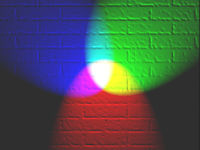
The color box at right shows the most intense yellow representable in 8-bit RGB color model; yellow is a secondary color in an additive RGB space.
The three additive primaries in the RGB color system are the three colors of light chosen such as to provide the maximum gamut of colors that are capable of being represented on a computer or television set.
The measured light spectrum from yellow pixels on a typical computer display is complex, and very unlike the reflectance spectrum of a yellow object such as a banana.[3]
Yellow (CMYK)
| Yellow (CMYK) (subtractive primary, sRGB approximation) | ||
|---|---|---|
|
— Color coordinates — |
||
| Hex triplet | #FFEF00 | |
| RGBB | (r, g, b) | (255, 239, 0) |
| HSV | (h, s, v) | (56°, 100%, 100%) |
| Source | [1] CMYK | |
| B: Normalized to [0–255] (byte) |
||

Process yellow (also known as pigment yellow or printer's yellow) is one of the three colors typically used as subtractive primary colors, along with magenta and cyan. The CMYK system for color printing is based on using four inks, one of which is a yellow color. The purpose of the CMYK color system is to provide the maximum possible gamut of colors capable of being reproduced in printing.
Process yellow is in itself a standard color, and a fairly narrow range of yellow inks or pigments are used. Process yellow is based on a colorant that reflects the preponderance of red and green light, and absorbs most blue light, as shown in the reflectance spectra shown in the figure on the lower right.
Because of the characteristics of paint pigments and use of different color wheels, painters traditionally regard the complement of yellow as the color indigo or blue-violet.
Process yellow is not an RGB color, and there is no fixed conversion from CMYK primaries to RGB. Different formulations are used for printer's ink, so there can be variations in the printed color that is pure yellow ink.
Yellow (NCS)
| Yellow (NCS) | ||
|---|---|---|
|
— Color coordinates — |
||
| Hex triplet | #FFD300 | |
| sRGBB | (r, g, b) | (255, 211, 0) |
| HSV | (h, s, v) | (50°, 100%, 100[4]%) |
| Source | sRGB approximation to NCS 0580-Y[5] | |
| B: Normalized to [0–255] (byte) |
||
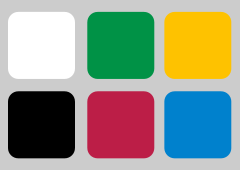
The yellow color used as a primary in the NCS or Natural Color System is shown at right (NCS 0580-Y). The Natural Color System is a color system based on the four unique hues or psychological primary colors red, yellow, green, and blue. These hues are an average derived from individual variations recorded by different observers. The NCS is based on the opponent process theory of vision.
The “Natural Color System” is widely used in Scandinavia.
Yellow (Munsell)
| Yellow (Munsell) | ||
|---|---|---|
|
— Color coordinates — |
||
| Hex triplet | #EFCC00 | |
| RGBB | (r, g, b) | (239, 204, 0) |
| HSV | (h, s, v) | (51°, 100%, 93[6]%) |
| Source | Munsell Color Wheel | |
| B: Normalized to [0–255] (byte) |
||
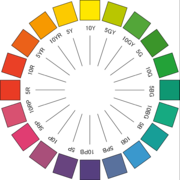
The yellow used as a primary in the Munsell color system (Munsell 5Y) is shown at right. The Munsell color system is a color space that specifies colors based on three color dimensions: hue, value (lightness), and chroma (color purity), spaced uniformly in three dimensions in the elongated oval at an angle shaped Munsell color solid according to the logarithmic scale which governs human perception. In order for all the colors to be spaced uniformly, it was found necessary to use a color wheel with five primary colors--red, yellow, green, blue, and purple.
The Munsell colors displayed are only approximate as they have been adjusted to fit into the sRGB gamut.
Etymology and linguistic definitions
The word yellow comes from the Old English geolu, or geolwe which derived from the Proto-Germanic word gelwaz.[7] The oldest known use of this word in English is in the Old English poem Beowulf, in a description of a shield made of wood from a yew tree.[8]
In the English language, yellow has traditionally been associated with jaundice and cowardice.[9] Yellow is associated with the word "caution" and is the second light on stop lights; in American slang, a coward can be said to be "yellowbellied" or "yellow".[10] The color is associated with aging as well, for both people and objects (e.g. "yellowed" paper). Ethnographically, the term "yellow" has been used as a slang term for both Asians ("yellow peril") and, in the early 20th century, light-skinned African-Americans (High yellow).
"Yellow" ("giallo"), in Italy, refers to crime stories, both fictional and real. This association began in about 1930, when the first series of crime novels published in Italy had yellow covers. The term "yellow movie" (黃色電影) can refer to films of pornographic nature in Chinese culture, and is analogous to the English "blue movie".[11] Lastly, it is associated with sensational journalistic practices, or yellow journalism, and resistance to militant trade unions.[8]
In science
Colorimetry
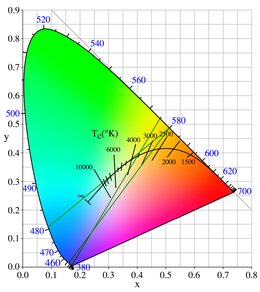
Hunt defines that "two colors are complementary when it is possible to reproduce the tristimulus values of a specified achromatic stimulus by an additive mixture of these two stimuli."[12] That is, when two colored lights can be mixed to match a specified white (achromatic, non-colored) light, the colors of those two lights are complementary. This definition, however, does not constrain what version of white will be specified. In the nineteenth century, the scientists Grassmann and Helmholtz did experiments in which they concluded that finding a good complement for spectral yellow was difficult, but that the result was indigo, that is, a wavelength that today's color scientists would call violet. Helmholtz says "Yellow and indigo blue" are complements.[13] Grassman reconstructs Newton's category boundaries in terms of wavelengths and says "This indigo therefore falls within the limits of color between which, according to Helmholtz, the complementary colors of yellow lie."[14] Newton's own color circle has yellow directly opposite the boundary between indigo and violet. These results, that the complement of yellow is a wavelength shorter than 450 nm, are derivable from the modern CIE 1931 system of colorimetry if it is assumed that the yellow is about 580 nm or shorter wavelength, and the specified white is the color of a blackbody radiator of temperature 2800 K or lower (that is, the white of an ordinary incandescent light bulb). More typically, with a daylight-colored or around 5000 to 6000 K white, the complement of yellow will be in the blue wavelength range, which is the standard modern answer for the complement of yellow.
Astronomy
Stars of spectral classes F and G, such as our sun Sol, have color temperatures that make them look "yellowish".[15] The first astronomer to classify stars according to their color was F. G. W. Struve in 1827. One of his classifications was flavae, or yellow, and this roughly corresponded to stars in the modern spectral range F5 to K0.[16] The Strömgren photometric system for stellar classification includes a 'y' or yellow filter that is centered at a wavelength of 550 nm and has a bandwidth of 20–30 nm.[17][18]
Biology
Pigments
- Carotenoids are organic pigments which give many biological objects, including egg yolks, autumn leaves and yellow flowers, their color.
- Yellow pan traps are used to capture insects, many of which are attracted to shades of yellow.[19][20]
Birds
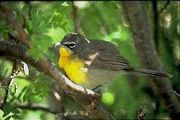
- Yellow-breasted Chats (Icteria virens) are large foraging songbird found in southern parts of Canada, the United States, Mexico, and Central America. They are olive with a white bellie and a yellow throat and breast, with a long tail, a thick heavy bill, a large white eye ring, and dark legs.
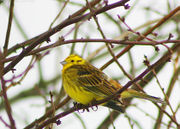
- The Yellowhammer (Emberiza citrinella) is a passerine in the bunting family Emberizidae. It breeds across Europe and much of Asia. Most yellowhammers are resident, but some far northern birds migrate south in winter. It is common in all sorts of open areas with some scrub or trees. They are large with a thick seed-eater's bill. The males have a bright yellow head, yellow underparts, and a heavily streaked brown back. Females are much duller and more streaked below.
- The Yellow-shafted Flicker (Colaptes auratus) is a large woodpecker species of eastern North America. They have yellow shafts on their wing and tail feathers.
Fish
- Yellowtail is the common name for dozens of different fish species that have yellow tails or a yellow body.
- Yellowfin tuna (Thunnus albacares) is a species of tuna, having bright yellow anal and second dorsal fins. Found in tropical and subtropical seas and weighing up to 200 kg (440 lb), it is caught as a replacement for the depleted stocks of bluefin tuna.
Insects
- A yellow-fever mosquito is a mosquito in the Aedes genus, so named because they transmit dengue fever and yellow fever, the mosquito-born viruses.
- Yellowjackets are black-and-yellow wasps of the genus Vespula or Dolichovespula (though some can be black-and-white, the most notable of these being the bald-faced hornet, Dolichovespula maculata). They can be identified by their distinctive black-and-yellow color, small size (slightly larger than a bee), and entirely black antennae.
Trees
- The yellow birch (Betula alleghaniensis) is a birch species native to eastern North America, from Nova Scotia, New Brunswick, and southern Quebec west to Minnesota, and south in the Appalachian Mountains to northern Georgia. They are medium-sized deciduous trees and can reaching about 20 m tall, trunks up to 80 cm in diameter. The bark is smooth and yellow-bronze[21] and the wood is extensively used for flooring, cabinetry, and toothpicks.
- The Thorny yellowwood is an Australian rainforest tree which has deep yellow wood.
- Yellow poplar is a common name for Liriodendron, the tuliptree. The common name is inaccurate as this genus is not related to poplars.
Other plants
- Rapeseed (Brassica napus), also known as rape or oilseed rape, is a bright yellow flowering member of the family Brassicaceae (mustard or cabbage family).
- Goldenrod is a yellow flowering plant in the Family Asteraceae
Lasers
Lasers emitting in the yellow part of the spectrum are much less common than most other colors.[22] They are also much more expensive than comparable lasers because the difference in energy levels between the metastable and the ground state required for laser action is difficult to create for yellow photons. In commercial products diode pumped solid state (DPSS) technology is employed to create the yellow light. An infrared laser diode at 808 nm is used to pump a crystal of neodymium-doped yttrium vanadium oxide (Nd:YVO4) or neodymium-doped yttrium aluminium garnet (Nd:YAG) and induces it to emit at two frequencies (wavelengths of 1064 nm and 1342 nm) simultaneously. This deeper infrared light is then passed through another crystal containing potassium, titanium and phosphorus (KTP), whose non-linear properties generate light at a frequency that is the sum of the two incident beams; in this case corresponding to the wavelength of 593.5 nm ("yellow").[23] This not a true yellow, as it exceeds 580 nm. A truly yellow laser has yet to be made.
Minerals and chemistry
- Yellowcake (also known as urania and uranic oxide) is concentrated uranium oxide, obtained through the milling of uranium ore. Yellowcake is used in the preparation of fuel for nuclear reactors and in uranium enrichment, one of the essential steps for creating nuclear weapons.

- Titan yellow (also known as clayton yellow),[24] chemical formula C28H19Na2O6S4 has been used to determine magnesium in serum and urine, but the method is prone to interference, making the ammonium phosphate method superior when analysing blood cells, food or fecal material.[25]
- Methyl yellow (p-Dimethylaminoazobenzene) is a pH indicator used to determine acidity. It changes from yellow at pH=4.0 to red at pH=2.9.[26][27]
- Yellow fireworks are produced by adding sodium compounds to the firework mixture. Sodium has a strong emission at 589.3 nm (D-line), a very slightly orange-tinted yellow.
- Amongst the elements, sulfur and gold are most obviously yellow. Phosphorus, arsenic and antimony have allotropes which are yellow or whitish-yellow; Fluorine and chlorine are pale yellowish gases.
Pigments
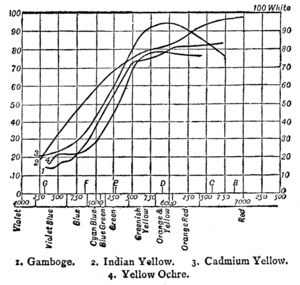
- Yellow ochre (also known as Mars yellow, Pigment yellow 42, 43),[28] hydrated ferric oxide (Fe2O3.H2O), is a naturally occurring pigment found in clays in many parts of the world. It is non-toxic and has been used in painting since prehistoric times.[29]
- Indian yellow is a transparent, fluorescent pigment used in oil paintings and watercolors. Originally magnesium euxanthate, it was claimed to have been produced from the urine of Indian cows fed only on mango leaves.[30] It has now been replaced by synthetic Indian yellow hue.
- Naples Yellow (lead antimonate yellow) is one of the oldest synthetic pigments, derived from the mineral bindheimite and used extensively up to the 20th century.[31] It is toxic and nowadays is replaced in paint by a mixture of modern pigments.
- Cadmium Yellow (cadmium sulfide, CdS) has been used in artists' paints since the mid-19th century.[32] Because of its toxicity, it may nowadays be replaced by azo pigments.
- Chrome Yellow (lead chromate, PbCrO4), derived from the mineral crocoite, was used by artists in the earlier part of the 19th century, but has been largely replaced by other yellow pigments because of the toxicity of lead.[33]
- Titanium Yellow (nickel antimony titanium yellow rutile, NiO.Sb2O5.20TiO2) is created by adding small amounts of the oxides of nickel and antimony to titanium dioxide and heating. It is used to produce yellow paints with good white coverage and has the LBNL paint code "Y10".[34]
- Gamboge is an orange-brown resin, derived from trees of the genus Garcinia, which becomes yellow when powdered.[35] It was used as a watercolor pigment in the far east from the 8th century - the name "gamboge" is derived from "Cambodia" - and has been used in Europe since the 17th century.[36]
- Orpiment, also called King's Yellow or Chinese Yellow is arsenic trisulfide (As2S3) and was used as a paint pigment until the 19th century when, because of its high toxicity and reaction with lead-based pigments, it was generally replaced by Cadmium Yellow.[37]
- Azo-dye based pigment (a brightly colored transparent or semitransparent dye with a white pigment) is used as the colorant in most modern paints requiring either a highly saturated yellow or simplicity of color mixing. The most common is the monoazo arylide yellow family, first marketed as Hansa Yellow.
In culture
Cultural associations
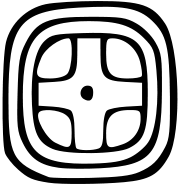
- The ancient Maya associated the color yellow with the direction South.[38] The Maya glyph for "yellow" (k'an) also means "precious" or "ripe".[39]
- The color is traditionally associated with the Malay Rulers of Malaysia.
- The word yellow can be used as an adjective meaning cowardly.
History
- The legendary first emperor of China was known as the Yellow Emperor or Huang Di (Chinese: 黃帝, Simplified Chinese: 黄帝). Members of the imperial family of China at that time were the only ones allowed to display the color yellow in buildings and garments.
- The Yellow Turbans were a Daoist sect that staged an extensive rebellion during the Han Dynasty.
Journalism
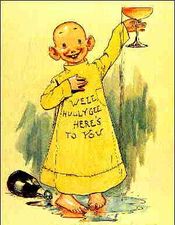
- "Yellow journalism" is a term that refers to sensationalist journalism that distorts, exaggerates, or exploits news to maximize profit. The term came from Joseph Pulitzer's New York World and William Randolph Hearst's New York Journal American, who engaged in sensational reporting during the late 19th and early 20th century, most famously during the Spanish-American War. The term was derived from the color comic strip The Yellow Kid, which appeared in both papers.
Music
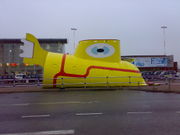
- The Beatles 1966 album Revolver features the #1 hit, "Yellow Submarine". Subsequently United Artists released an animated film in 1968 called "Yellow Submarine", based on the music of the Beatles.
- The March 1967 album by Donovan called Mellow Yellow was very popular among the hippies. The featured song on the album, "Mellow Yellow", popularized during the Spring of 1967 a widely believed hoax that it was possible to get high by smoking scrapings from the inside of banana peels, although this rumor was actually started in 1966 by a different musician popular among the hippies, Country Joe McDonald.
- Coldplay achieved worldwide fame with their 2000 single "Yellow". It is a song that associates things the singer sees with the color yellow.
Politics
- Yellow is one of two colors used by Santugon sa Tawag ng Panahon which is a Socio-Political Organization in De La Salle University
- Yellow was also the color of the New Party in the Republic of China (Taiwan), which supports Chinese reunification.
- In the United States, a yellow dog Democrat was a Southern voter who consistently voted for Democratic candidates in the late 19th and early 20th centuries because of lingering resentment against the Republicans dating back to the Civil War and Reconstruction period. Today the term refers to a hard-core Democrat, supposedly referring to a person who would vote for a "yellow dog" before voting for a Republican.
- Yellow is also associated in the United States with the Libertarian Party, to contrast with the Democratic Party (blue) and Republican Party (red).
- In the United Kingdom, The Monster Raving Loony Party (OMRLP) has made use of yellow, along with black, as its primary party colors.
- During the People Power Revolution of 1986, yellow was the dominant theme, the color being associated with former Philippine President Corazon Aquino. It is now a symbol of both support for her as well as in commemoration of the popular revolt.
- In the United Kingdom, yellow is associated with the Liberal Democrats and British Liberalism in general.
- In Europe, many liberal parties use yellow in a combination with blue, such as Free Democratic Party (Germany), Liberal Forum (Austria), Estonian Reform Party and Liberal and Centre Union (Lithuania).
Religion and metaphysics
- The Christian holiday of Easter is represented by the colors yellow and lavender because the crocus flower, which is yellow and lavender, blooms in Europe in spring.
- In the metaphysics of the New Age Prophetess, Alice A. Bailey, in her system called the Seven Rays which classifies humans into seven different metaphysical psychological types, the fourth ray of harmony through conflict is represented by the color yellow. People who have this metaphysical psychological type are said to be on the Yellow Ray. "[40]
- In Hinduism, yellow is used to symbolically represent the third, solar plexus chakra (Manipura).[41]
- Psychics who claim to be able to observe the aura with their third eye report that someone with a yellow aura is typically someone who is in an occupation requiring intellectual acumen, such as a scientist.[42]
Sports
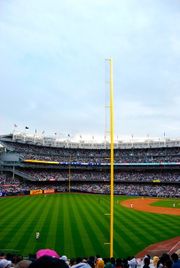
- In Association football (soccer), the referee shows a yellow card to indicate that a player has been officially cautioned because they have committed a foul or have wasted time.
- In American Football, a yellow flag is thrown onto the field by a referee to indicate a penalty.
- Originally in Rugby League and then later, also in Rugby Union, the referee shows a yellow card to indicate that a player has been sent to the sin bin.
- In auto racing, a yellow flag signals caution. Cars are not allowed to pass one another under a yellow flag.
- In cycle racing, the yellow jersey - or maillot jaune - is awarded to the leader in a stage race. The tradition was begun in the Tour de France where the sponsoring L'Auto newspaper (later L'Équipe) was printed on distinctive yellow newsprint.
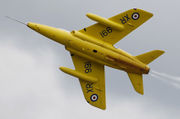

Transportation
- In some countries, taxicabs are commonly yellow. This practice began in Chicago, where taxi entrepreneur John D. Hertz painted his taxis yellow based on a University of Chicago study alleging that yellow is the color most easily seen at a distance.[43]
- In Canada and the United States, school buses are almost uniformly painted a yellow color (often referred to as "school bus yellow") for purposes of visibility and safety,[44] and British bus operators such as FirstGroup plc are attempting to introduce the concept there.[45]
- "Caterpillar yellow" and "high-visibility yellow" are used for highway construction equipment.[46]
- In the rules of the road, yellow (called "amber" in Britain) is a traffic light signal warning that the period in which passage is permitted is coming to an end.[47] It is intermediate between green (go) and red (stop). In railway signaling, yellow is often the color for warning, slow down, such as with distant signals.[48]
- Yellow warning signs, especially with black wording, borders, or alternating stripes, are used in many countries around the world to indicate caution, both as road signs and for other uses such as "caution, slippery floor".
- Several light rail and rapid transit lines on various public transportation have a Yellow Line.
Food and drinks
Some foods are yellow. These include bananas, lemons, corn and squash. Lemonade is originally yellow.
Vexillology
- In International maritime signal flags a yellow flag denotes the letter "Q".[49] It also means a ship asserts that it does not need to be Quarantined.[49]
See also
- List of colors
- CMYK color model
- RYB color model
- Sodium vapor lamp
References
- ↑ James W. Kalat (2005). Introduction to Psychology. Thomson Wadsworth. p. 105. ISBN 053462460X. http://books.google.com/?id=AHBnar7sEIIC&pg=PA105&lpg=PA105&dq=yellow-light+long+medium+short+cones.
- ↑ W3C TR CSS3 Color Module, HTML4 color keywords
- ↑ Craig F. Bohren and Eugene E. Clothiaux (2006). Fundamentals of Atmospheric Radiation. Wiley-VCH. ISBN 3527405038. http://books.google.com/?id=1oDOWr_yueIC&pg=PA215&lpg=PA215&dq=%22measured+spectrum+of+computer+display+yellow+pixels%22.
- ↑ web.forret.com Color Conversion Tool set to hex code #FFD300 (Yellow (NCS)):
- ↑ The sRGB values are taken by converting the NCS color 0580-Y using the “NCS Navigator” tool at the NCS website.
- ↑ web.forret.com Color Conversion Tool set to hex code #EFCC00 (Yellow (Munsell)):
- ↑ Online Etymology Dictionary
- ↑ 8.0 8.1 Oxford English Dictionary
- ↑ Hodgson, Charles (2007). Carnal Knowledge. Macmillan. pp. 133. ISBN 0312371217.
- ↑ Houghton Mifflin Company (2004). The American heritage college thesaurus. Oxford University Press. pp. 180. ISBN 0618402195.
- ↑ Hewitt, Duncan (2000-11-28). "Chinese porn trader jailed for life". BBC News. http://news.bbc.co.uk/1/hi/world/asia-pacific/1045153.stm. Retrieved 2009-03-23.
- ↑ J. W. G. Hunt (1980). Measuring Color. Ellis Horwood Ltd. ISBN 0-7458-0125-0.
- ↑ Hermann von Helmholtz (1924). Physiological Optics. Dover.
- ↑ Hermann Günter Grassman (1854). "Theory of Compound Colors". Philosophical Magazine 4: 254–264.
- ↑ Ron Miller (2005). Stars and Galaxies. Twenty-First Century Books. p. 22. ISBN 9780761334668. http://books.google.com/?id=QL9uAfad1ggC&pg=PA22&dq=spectral-class+yellow.
- ↑ Murdin, Paul (1984). Colours of the stars. CUP Archive. p. 18. ISBN 052125714X.
- ↑ Strömgren, Bengt. "Main Sequence Stars, Problems of Internal Constitution and Kinematics (George Darwin Lecture)". Quarterly Journal of the Royal Astronomical Society 8: 8–37. Bibcode: 1963QJRAS...4....8S. http://adsabs.harvard.edu/abs/1963QJRAS...4....8S. Retrieved 2009-04-21.
- ↑ Norton, Andrew; Cooper, W. Alan Cooper (2004). Observing the universe: a guide to observational astronomy and planetary science. Cambridge University Press. p. 63. ISBN 0521603935.
- ↑ Kisimoto,Ryoiti (1968) Yellow Pan Water Trap for Sampling the Small Brown Planthopper, Laodelphax striatellus (FALLEN), a Vector of the Rice Stripe Virus. Japanese Society of Applied Entomology and Zoology 3(1):37-48
- ↑ Webb, S. E., M. L. Kok-Yokomi, and D. J. Voegtlin (1994) Effect of Trap Color on Species Composition of Alate Aphids (Homoptera: Aphididae) Caught over Watermelon Plants Florida Entomologist 77(1):146-153 PDF
- ↑ River Birch Trees | Fall Foliage | White Birches
- ↑ "Laserglow - Blue, Red, Yellow, Green Lasers". Laserglow.com. http://www.laserglow.com/index.php?portable. Retrieved 2009-03-27. - described as "Very rare yellow laser colour".
- ↑ Johnson, Craig (22 March 2009). "Yellow (593.5nm) DPSS Laser Module". The LED Museum. http://ledmuseum.candlepower.us/yelldpss.htm. Retrieved 2009-03-27.
- ↑ "Titan Yellow". Nile Chemicals. 26 July 2008. http://www.nilechemicals.com/TitanYellow.htm. Retrieved 2009-03-28.
- ↑ Heaton, FW (July 1960). "Determination of magnesium by the Titan yellow and ammonium phosphate methods". Journal of Clinical Pathology 13: 358–60. doi:10.1136/jcp.13.4.358. PMID 14400446. PMC 480095. http://jcp.bmj.com/cgi/pmidlookup?view=long&pmid=14400446.
- ↑ "para-Dimethylaminobenzene". IARC - Summaries & Evaluations (International Agency for Research on Cancer) 8: 125. 1975. http://www.inchem.org/documents/iarc/vol08/p-dimethylaminobenzene.html. Retrieved 2009-04-08.
- ↑ "Ph paper, Litmus paper, ph indicator, laboratory stain". GMP ChemTech Private Limited. 2003. http://www.gmpct.com/products/stains_indicators_indicator_paper.php. Retrieved 2009-04-08.
- ↑ "Health & Safety in the Arts". City of Tucson. http://www.ci.tucson.az.us/arthazards/paint1.html. Retrieved 2009-03-28.
- ↑ "Pigments through the ages: Yellow ochre". WebExhibits. http://www.webexhibits.org/pigments/indiv/overview/yellowochre.html. Retrieved 2009-03-28.
- ↑ Harley, Rosamond Drusilla (2001). Artists' Pigments c1600-1835 (2 ed.). London: Archetype Publications. p. 117. ISBN 1-873132-91-3. OCLC 47823825. http://painting.about.com/od/productreviews/gr/RDHarley_pigmt.htm. Retrieved 2009-03-30.
- ↑ "Pigments through the ages: Naples yellow". WebExhibits. http://www.webexhibits.org/pigments/indiv/overview/naplesyellow.html. Retrieved 2009-03-30.
- ↑ "Pigments through the ages: Cadmium yellow". WebExhibits. http://www.webexhibits.org/pigments/indiv/history/cdyellow.html. Retrieved 2009-04-05.
- ↑ "Pigments through the ages: Chrome yellow". WebExhibits. http://www.webexhibits.org/pigments/indiv/history/cryellow.html. Retrieved 2009-04-05.
- ↑ "LBNL Pigment Database: (Y10) Nickel Antimony Titanium Yellow Rutile (iii)". Lawrence Berkeley National Lab. 14 February 2005. http://coolcolors.lbl.gov/LBNL-Pigment-Database/paints/Y10.html. Retrieved 2009-04-05.
- ↑ "gamboge (gum resin)". Britannica Online Encyclopedia. http://www.britannica.com/EBchecked/topic/224855/gamboge. Retrieved 2009-04-07.
- ↑ "Gamboge". Sewanee: The University of the South. 16 July 2002. http://www.sewanee.edu/chem/Chem&Art/Detail_Pages/Pigments/Gamboge. Retrieved 2009-04-07.
- ↑ Field, George (1869). Salter, Thomas. ed. Field's Chromatography or Treatise on Colours and Pigments as Used by Artists. London: Winsor and Newton. http://www.gutenberg.org/ebooks/20915.
- ↑ Rjabchikov, Sergei V (31 December 2006). "Several Remarks on the Maya Script". The AnthroGlobe Journal. http://www.anthroglobe.info/docs/rjabchikovs_mayascript_061231.html. Retrieved 2009-03-28.
- ↑ Kettunen, Harri; Helmke, Christophe (5 December 2005). Introduction to Maya Hieroglyphs (Workshop Handbook 10th European Maya Conference). Leiden: Wayeb & Leiden University. pp. 75. http://www.docstoc.com/docs/2688831/Introduction-to-Maya-Hieroglyphs. Retrieved 2009-03-28.
- ↑ Bailey, Alice A. (1995). The Seven Rays of Life. New York: Lucis Publishing Company. ISBN 0853301425.
- ↑ Stevens, Samantha. The Seven Rays: a Universal Guide to the Archangels. City: Insomniac Press, 2004. ISBN 1-894663-49-7 pg. 24
- ↑ Swami Panchadasi The Human Aura: Astral Colors and Thought Forms Des Plaines, Illinois, USA:1912--Yogi Publications Society Page 33
- ↑ "History of the Main Taxi Groups". Taxi Register. http://www.taxiregister.com/history.php. Retrieved 2009-04-04.
- ↑ "Frank W. Cyr, 95, 'Father of the Yellow School Bus'". Columbia University Record (Columbia University) 21 (1). September 8, 1995. http://www.columbia.edu/cu/record/archives/vol21/vol21_iss1/record2101.36.html. Retrieved April 4, 2009.
- ↑ "Review backs yellow school buses". BBC. 12 September 2008. http://news.bbc.co.uk/1/hi/uk_politics/7610933.stm. Retrieved 2009-04-04.
- ↑ Caterpillar Global Mining (Caterpillar): 4. Maximizing Mining Safety. http://www.cat.com/cda/files/1042221/7/final.pdf.
- ↑ Robert Dinwiddle, ed (August 2001). Science Year by Year. Popular Science. Scholastic Corporation. pp. 45. ISBN 0-493-28438-4.
- ↑ Bej, Mark (April 16, 1994). "Learning the ["typical" US] Aspects". http://broadway.pennsyrr.com/Rail/Signal/learning_the_aspects.html. Retrieved 2009-04-04.
- ↑ 49.0 49.1 Flag and Etiquette Committee (June 12, 2006). "Pratique". Flag Etiquette. United States Power Squadrons. http://www.usps.org/f_stuff/pratique.html. Retrieved 2009-04-04.
|
|||||||||||||||||
| Shades of yellow | |||||||||
|---|---|---|---|---|---|---|---|---|---|
| Amber | Apricot | Arylide yellow | Aureolin | Beige | Blond | Buff | Chartreuse yellow | Chrome yellow | Citrine |
| Cream | Dark goldenrod | Ecru | Flavescent | Flax | Fulvous | Gamboge | Gold | Gold (metallic) | Goldenrod |
| Golden poppy | Golden yellow | Green-yellow | Hansa yellow | Icterine | Isabelline | Jonquil | Khaki | Lemon | Lemon chiffon |
| Lime | Maize | Mikado yellow | Mustard | Naples yellow | Navajo white | Old gold | Olive | Papaya whip | Peach-yellow |
| Pear | Saffron | School bus yellow | Selective yellow | Stil de grain yellow | Sunglow | Tangerine yellow | Titanium yellow | Urobilin | Vanilla |
| Vegas gold | Yellow | ||||||||
| The samples shown above are only indicative. | |||||||||
| Web colors | |||||||||||||||
|---|---|---|---|---|---|---|---|---|---|---|---|---|---|---|---|
| black | gray | silver | white | maroon | red | purple | fuchsia | green | lime | olive | yellow | navy | blue | teal | aqua |
|
|||||||||||